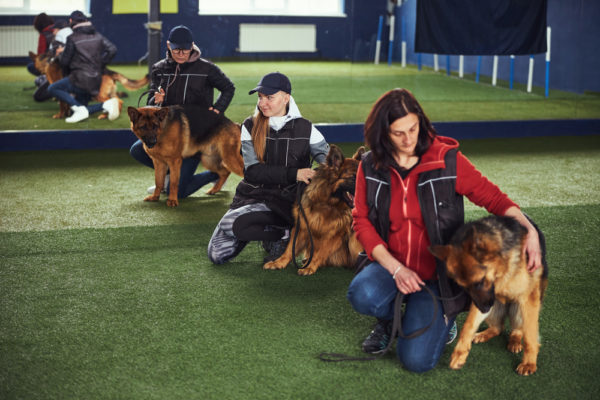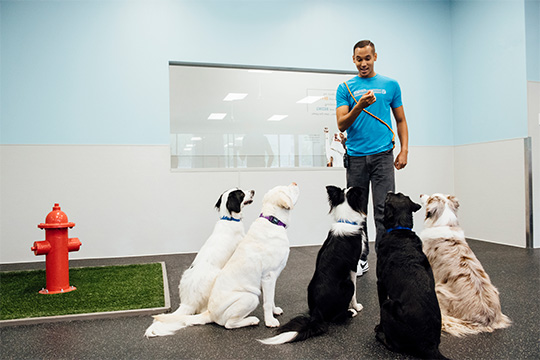Get Results with Puppy Training That Sets the Foundation for a Well-Behaved Dog
Get Results with Puppy Training That Sets the Foundation for a Well-Behaved Dog
Blog Article
Transform Your Pet's Actions With Proven Training Approaches
Changing your pet dog's actions needs a nuanced understanding of their individual qualities and needs, as well as the application of tried and tested training techniques. Consistency in your training approach not just enhances obedience however additionally promotes a deeper bond of trust fund and regard between you and your pet.

Recognizing Dog Behavior
Recognizing pet dog behavior is essential for reliable training and communication in between human beings and their canine companions. Pets, as social pets, display a series of habits affected by genes, atmosphere, and experiences. Identifying these actions helps owners tailor their training approaches to satisfy the specific requirements of their pets.
Key aspects of pet dog actions include body language, articulations, and social communications. Furthermore, socialization plays an important function in shaping behavior; canines that connect favorably with various other animals and various individuals are usually more well-adjusted and versatile.
Furthermore, acknowledging anxiety signals-- such as panting, pacing, or evasion behaviors-- can protect against escalation into a lot more major issues. Owners that are attuned to their pet's habits can create a risk-free and caring setting, promoting trust and enhancing the training process. Ultimately, a deep understanding of canine behavior lays the foundation for a harmonious connection and reliable training end results, guaranteeing both dogs and their owners thrive together.
Positive Reinforcement Methods
Positive reinforcement methods are widely recognized as one of the most effective methods for training canines, promoting a favorable understanding setting. This technique entails fulfilling wanted behaviors with deals with, praise, or play, therefore urging the dog to duplicate those actions (Dog training). Unlike revengeful approaches, favorable reinforcement builds trust and enhances the bond between the dog and the instructor
Incentives should be given promptly adhering to the desired habits to help the pet make the link. Consistency is likewise essential; using the exact same commands and rewards assists the dog recognize what is anticipated.
It is very important to note that positive support is not regarding bribery; rather, it is concerning strengthening etiquette. In time, as the pet discovers to link certain activities with positive outcomes, the frequency of rewards can be slowly decreased, transitioning to verbal appreciation or periodic rewards. This technique not just encourages obedience yet also promotes a certain and happy pet, making training a much more delightful experience for both events involved.
Dealing With Typical Issues
Resolving usual issues throughout pet training is important for making sure a effective and harmonious relationship in between the dog and its owner. Several canine owners experience behavior difficulties, such as excessive barking, jumping, and leash drawing. Comprehending the root triggers of these actions is critical for reliable training.
Too much barking might come from boredom, stress and anxiety, or a lack of socialization. To reduce this, supply ample workout, mental excitement, and opportunities for social interaction with both people and other pet dogs. Jumping can commonly signify enjoyment or a wish for focus. Educating the dog to rest upon welcoming can redirect this actions favorably.
Leash drawing is another prevalent issue, regularly arising from a dog's passion to explore. Utilizing appropriate chain taking care of techniques, incorporated with training methods that encourage loose-leash walking, can significantly enhance this behavior.
Additionally, problems like resource guarding or separation anxiousness require tailored techniques. Progressive desensitization and counter-conditioning can be efficient in resolving these challenges. By identifying and proactively taking care of these typical problems, dog owners can foster an extra enjoyable training experience and enhance the bond with their canine companions.
Consistency in Training
Uniformity is a foundation of effective dog training, as it develops a clear framework for the dog to understand assumptions and actions. When benefits, commands, and signs are applied uniformly, dogs can more readily understand what is called for of them. Inconsistent training can result in complication, causing unwanted habits that discourage both the canine and the trainer.
To achieve uniformity, it is vital that all members of the house follow the same training approaches. For instance, making use of the same spoken signs and hand signals ensures that the pet dog receives consistent messages. Additionally, the timing of benefits and corrections need to be regular; instant reinforcement increases the probability that the pet will certainly associate the behavior with the outcome.
Additionally, developing a routine can further enhance consistency. Normal session, coupled with organized routines for feeding, strolling, and playtime, assistance pets expect and understand their setting, making them much more receptive to training. Eventually, uniformity cultivates a complacency and trust, equipping dogs to find out more properly. By devoting to a structured technique, trainers can promote favorable actions adjustments and grow a courteous friend.
Building a Strong Bond
Exactly how can fostering a solid bond between a pet dog and its owner boost the training experience? When a pet feels secure in its link with its owner, it is more likely to exhibit favorable habits and be receptive to learning.

In addition, a reputable connection can minimize anxiousness and behavior issues, as pet dogs are less likely to act out when they really feel recognized and cared for. Prioritizing the advancement of a strong bond not only boosts the training experience yet also adds to a happier and a lot more well-adjusted dog. Inevitably, the journey of training changes right into a collaborative partnership, leading to lasting behavior improvements.
Final Thought

Proprietors who are attuned to their canine's behavior can develop a secure and nurturing environment, promoting trust fund and improving the training process. Eventually, a deep understanding of canine habits lays the foundation for a harmonious partnership and effective training results, ensuring both dogs and their owners flourish together.
Addressing typical issues during dog training is crucial for ensuring a harmonious and successful connection between the pet dog and its owner (Dog training).Uniformity is a foundation of effective pet training, as it develops a clear structure for the canine to recognize habits and expectations.In conclusion, transforming a pet dog's habits via verified training methods requires an understanding of canine behavior, the application of favorable support techniques, and an emphasis on uniformity
Report this page